Adinkra symbol เป็นสัญลักษณ์ที่มีความหมายต่างๆ ที่ถือกำเนิดจากลายพิมพ์บนผืนผ้าฝ้าย ที่ชาว Akan ในประเทศ กาน่า ใช้นุ่งห่มในพิธีงานศพ ตั้งแต่ต้นๆ ศตวรรษที่ 19 โดยแต่ละสัญลักษณ์นั้นจะมีชื่อเรียก และความหมาย ในภาษา Twi ถึงถือเป็นภาษาของชาว Asante ที่สืบทอดเชื้อสายมาจากชาว Akan
ผ้าพิมพ์ลาย Adinkra ที่นิยมใช้ในงานศพจะเป็นผ้าพื้นสีดำ น้ำตาล (Kuntumkuni) ลวดลาย จะเป็นลายอิฐสีแดง Kobone และสีดำ Birini
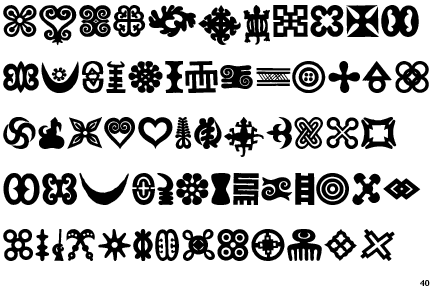
ลวดลาย ของ Adinkra Symbol และความหมาย

ADINKRAHENE
"Chief of the adinkra symbols"
symbol of greatness, charisma and leadership
This symbol is said to have played an inspiring role in the designing of other symbols. it signifies the importance of playing a leadership role.
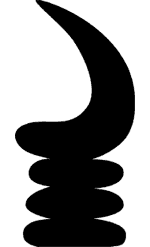
AKOBEN
"war horn"
symbol of vigilance and wariness
Akoben is a horn used to sound a battle cry
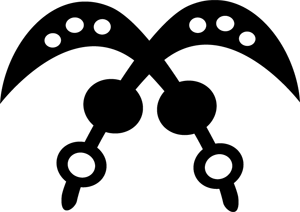
AKOFENA
"sword of war "
symbol of courage, valor, and heroism
The crossed swords were a popular motif in the heraldic shields of many former Akan states. In addition to recognizing courage and valor, the swords can represent legitimate state authority.
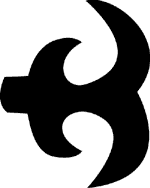
AKOKO NAN
"the leg of a hen"
symbol of nurturing and discipline
The full name of this symbol translates to "The hen treads on her chicks, but she does not kill them." This represents the ideal nature of parents, being both protective and corrective. An exhortation to nurture children, but a warning not to pamper them.

AKOMA
"the heart"
symbol of patience and tolerance
According to Agbo, when a person is said to "have a heart in his stomach," that person is very tolerant.
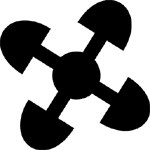
AKOMA NTOSO
"linked hearts"
symbol of understanding and agreement
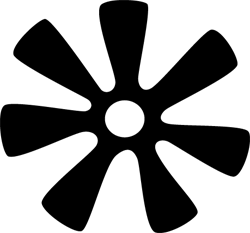
ANANSE NTONTAN
"spider's web"
symbol of wisdom, creativity and the complexities of life
Ananse, the spider, is a well-known character in African folktales.
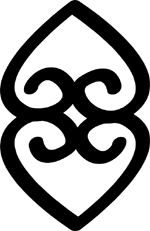
ASASE YE DURU
"the Earth has weight"
symbol of providence and the divinity of Mother Earth
This symbol represents the importance of the Earth in sustaining life.
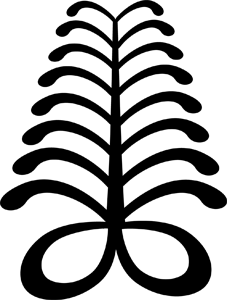
AYA
"fern"
symbol of endurance and resourcefulness
The fern is a hardy plant that can grow in difficult places. "An individual who wears this symbol suggests that he has endured many adversities and outlasted much difficulty."
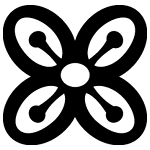
"sack of cola nuts"
symbol of affluence, power, abundance, plenty, togetherness and unity
The cola nut played an important role in the economic life of Ghana. A widely-used cash crop, it is closely associated with affluence and abundance. This symbol also represents the role of agriculture and trade in bringing peoples together.
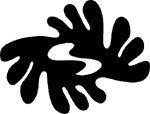
BI NKA BI
"No one should bite the other"
symbol of peace and harmony
This symbol cautions against provocation and strife. The image is based on two fish biting each other tails.
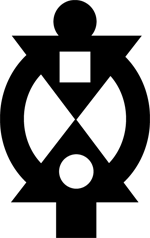
FAWOHODIE
"independence"
symbol of independence, freedom, emancipation
"From the expression: Fawodhodie ene obre na enam.
Literal translation: "Independence comes with its responsibilities."
BOA ME NA ME MMOA WO
"Help me and let me help you"
symbol of cooperation and interdependence
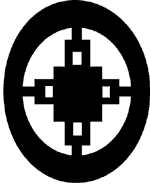
BI NKA BI
"No one should bite the other"
symbol of peace and harmony
This symbol cautions against provocation and strife. The image is based on two fish biting each other tails.
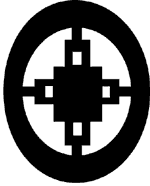
DAME-DAME
name of a board game
symbol of intelligence and ingenuity
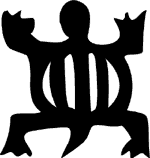
DENKYEM
"crocodile"
symbol of adaptability
The crocodile lives in the water, yet breathes the air, demonstrating an ability to adapt to circumstances.
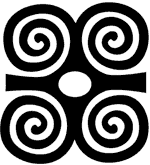
DUAFE
"wooden comb"
symbol of beauty and cleanliness; symbols of desirable feminine qualities
The meaning of this symbol is characterized slightly differently in "The Adinkra Dictionary" and "The Values of Adinkra Symbols"; the former emphasizes more abstract qualities of feminine goodness, love and care, while the latter has a more literal interpretation, looking one's best and good hygiene. In any case, the duafe was a prized possession of the Akan woman, used to comb and plait her hair
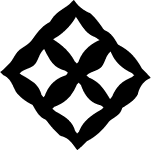
EBAN
"fence"
symbol of love, safety and security
The home to the Akan is a special place. A home which has a fence around it is considered to be an ideal residence.
The fence symbolically separates and secures the family from the outside. Because of the security and the protection that a fence affords, the symbol is also associated with the security and safety one finds in love.

EPA
"handcuffs"
symbol of law and justice, slavery and captivity
Adolph Agbo, in "Values of Adinkra Symbols" notes that handcuffs were introduced in Africa as a result of the slave trade, and later became popular among chiefs in cuffing offenders of the law. "The symbol reminds offenders of the uncompromising nature of the law. It however discourages all forms of slavery."
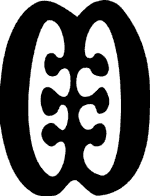
ESE NE TEKREMA
"the teeth and the tongue"
symbol of friendship and interdependence
The teeth and the tongue play interdependent roles in the mouth. They may come into conflict, but they need to work together.
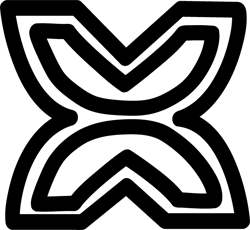
FAWOHODIE
"independence"
symbol of independence, freedom, emancipation
"From the expression: Fawodhodie ene obre na enam.
Literal translation: "Independence comes with its responsibilities."
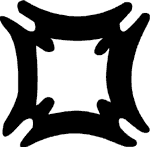
FIHANKRA
"house/compound"
symbol of security and safety
Typical of Akan (Asante) architecture, the communal housing compound has only one entrance and exit.
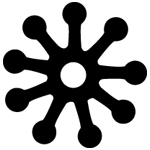
FOFO
"yellow flowered plant"
symbol of jealousy and envy
"When the fofo's petals drop, they turn into black spiky-like seeds. The Akan liken the nature of this plant to a jealous person."
There is a Akan proverb associated with this symbol: "What the fofo plant wishes is that the gyinantwi seeds turn black."
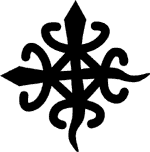
FUNTUNFUNEFU-DENKYEMFUNEFU
"Siamese crocodiles"
symbol of democracy and unity
The Siamese crocodiles share one stomach, yet they fight over food. This popular symbol is a remind that infighting and tribalism is harmful to all who engage in it.
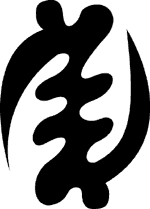
GYE NYAME
"except for God"
symbol of the supremacy of God
This unique and beautiful symbol is ubiquitous in Ghana. It is by far the most popular for use in decoration, a reflection on the deeply religious character of the Ghanaian people
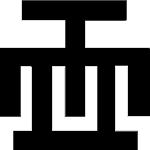
HWE MU DUA
"measuring stick"
symbol of examination and quality control
This symbol stresses the need to strive for the best quality, whether in production of goods or in human endeavors.
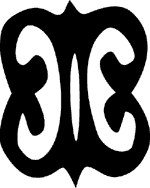
HYE WON HYE
"that which does not burn "
symbol of imperishability and endurance
This symbol gets its meaning from traditional priests that were able to walk on fire without burning their feet, an inspiration to others to endure and overcome difficulties.
.
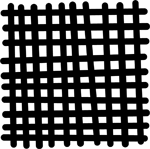
KETE PA
"good bed "
symbol of a good marriage
From the expression that a woman who has a good marriage is said to sleep on a good be
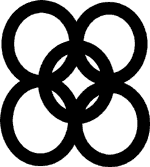
KINTINKANTAN
"puffed up extravagance"
symbol of arrogance
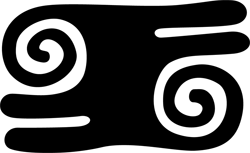
KWATAKYE ATIKO
"hair style of an Asante war captain"
symbol of bravery and valor
"This symbols is said to be a special hair style of Kwatakye, a war captain of old Asante.
The symbol has come to represent bravery and fearlessness. It is also given as an earned title to any brave son of an Akan community."
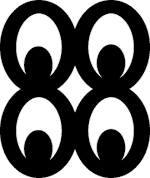
MATE MASIE
"What I hear, I keep"
symbol of wisdom, knowledge and prudence
The implied meaning of the phrase "mate masie" is "I understand". Understanding means wisdom and knowledge, but it also represents the prudence of taking into consideration what another person has said.
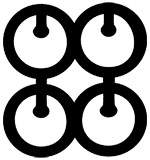
ME WARE WO
"I shall marry you "
symbol of commitment, perseverance
From the expression "No one rushes into the job of mixing the concrete for building the house of marriage."
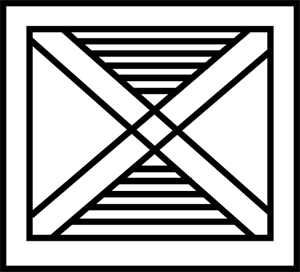
MFRAMADAN
"wind-resistant house"
symbol of fortitude and readiness to face life's vicissitudes
"This symbol suggests a reinforced or well-built home -- one built to withstand windy and treacherous conditions. It reflects in Asante history a clause in the unwritten constitutution of the Golden Stool. Oral acocunts say that according to that clause, mud houses in Kumasi must be reinforced with turf. This reinforcing would cause the house to be sturdier and resistant to unfavorable weather conditions."
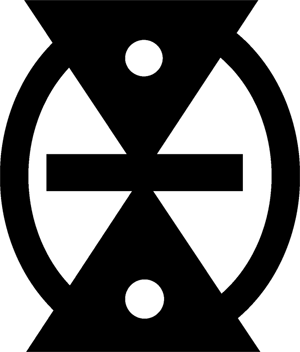
"time changes "
symbol of change, life's dynamics

MMUSUYIDEE
"that which removes bad luck"
symbol of good furtune and sanctity
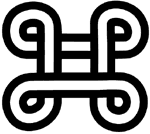
MPATAPO
"knot of pacification/reconciliation"
symbol of reconciliation, peacemaking and pacification
Mpatapo represents the bond or knot that binds parties in a dispute to a peaceful, harmonious reconciliation. It is a symbol of peacemaking after strife
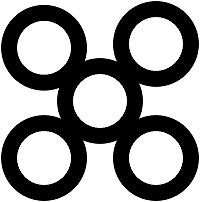
MPUANNUM
"five tufts" (of hair)
symbol of priestly office, loyalty and adroitness
"This symbol is said to be the hairstyle of joy. It is the traditional hairstyle of the priestesses. ... The design of the adinkra symbol mpuannum resembles the way the priestesses' hair was tied. ...
It also represents the devotion and faithfulness one displays when doing a task required of one. In addition, mpuannum means loyalty or the embodiment of lofty duty to a desired goal."
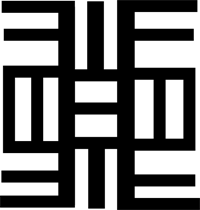
NEA ONNIM NO SUA A, OHU
"He who does not know can know from learning"
symbol of knowledge, life-long education and continued quest for knowledge
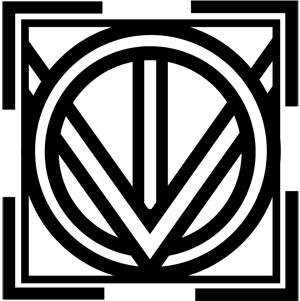
NEA OPE SE OBEDI HENE
"he who wants to be king "
symbol of service and leadership
From the expression "Nea ope se obedi hene daakye no, firi ase sue som ansa" meaning "He who wants to be king in the future must first learn to serve."
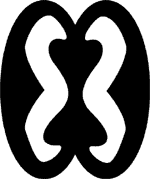
NKONSONKONSON
"chain link"
symbol of unity and human relations
A reminder to contribute to the community, that in unity lies strength
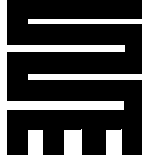
NKYINKYIM
"twisting"
symbol of initiative, dynamism and versatility
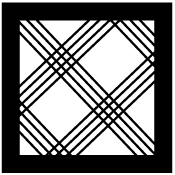
NKYIMU
the crossed divisions made on adinkra cloth before stamping
symbol of skillfulness, precision
Before adinkra cloth is stamped with the symbols, the artisan blocks off the cloth with lines in a rectangular grid using a broad-tooth comb. This preparation is symbolic of the exacting technique which results in the highest quality product.
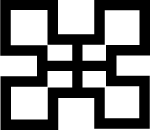
NSAA
a type of hand-woven fabric
symbol of excellence, genuineness, authenticity
According to "The Adinkra Dictionary" by W. Bruce Willis, the nsaa symbols reflects a saying: "nea onnim nsaa oto n'ago", which he translates as "He who does not know authentic Nsaa will buy the fakes."
The quality of Nsaa has come to represent quality of workmanship in general.
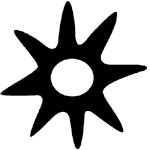
NSOROMMA
"child of the heavens [stars] "
symbol of guardianship
A reminder that God is the father and watches over all people.
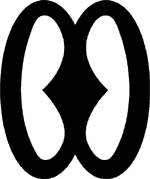
NYAME BIRIBI WO SORO
"God is in the heavens"
symbol of hope
A reminder that God's dwelling place is in the heaven, where he can listen to all prayers.
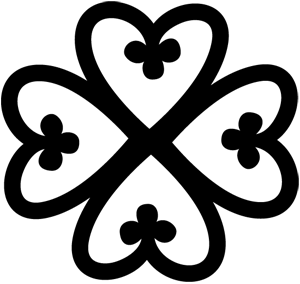
NYAME DUA
"tree of god" – altar
symbol of God's presence and protection
The Nyame Dua is a sacred spot where rituals are performed. Erected in front of the house or compound, it is crafted from a tree that has been cut where three or more branches come together. This stake holds an earthenware vessell filled with water and herbs or other symbolic materials for purification and blessing rituals.
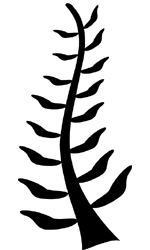
NYAME NTI
"by God's grace"
symbol of faith and trust in God
similar to Gye Nyame
According to The Adinkra Dictionary by W. Bruce Willis: "This stalk is depicted as the staff of life in many cultures. It symbolizes to the Akan that food is a basis of life and that they could not survive if not for the food that God has placed here on Earth for their nourishment. "
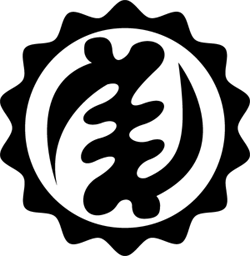
NYAME YE OHENE
"God is King "
symbol of majesty and supremacy of God
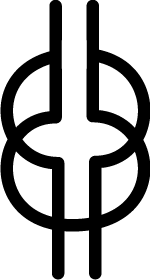
NYANSAPO
"wisdom knot"
symbol of wisdom, ingenuity, intelligence and patience
An especially revered symbol of the Akan, this symbol conveys the idea that "a wise person has the capacity to choose the best meeans to attain a goal. Being wise implies broad knowledge, learning and experience, and the ability to apply such faculties to practical ends
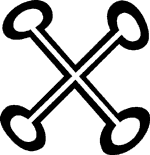
NYAME NNWU NA MAWU
"God never dies, therefore I cannot die"
symbol of God's omnipresence and the perpetual existence of man's spirit
This signifies the immortality of man's soul, believed to be a part of God. Because the soul rests with God after death, it cannot die.
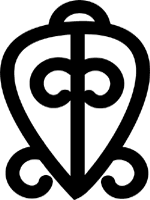 ODO NNYEW FIE KWAN
ODO NNYEW FIE KWAN"Love never loses its way home"
symbol of the power of love
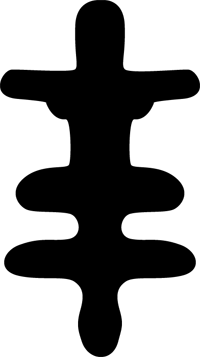
OKODEE MMOWERE
"the talons of the eagle"
symbol of strength, bravery, power
The eagle is the mightiest bird in the sky, and its strength is concentrated in its talons. The Oyoko clan, one of the nine Akan clans, uses this symbol as their clan emblem
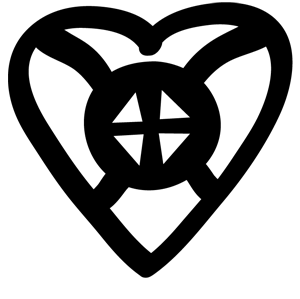
ONYANKOPON ADOM NTI BIRIBIARA BEYE YIE
"By God's grace, all will be well"
symbol of hope, providence, faith
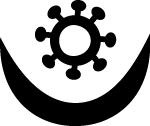
OSRAM NE NSOROMMA
"The Moon and the Star"
symbol of love, faithfulness, harmony
This symbol reflects the harmony that exists in the bonding between a man and a woman.
Proverb: "Kyekye pe aware." (The North Star has a deep llove for marriage. She is always in the sky waiting for the return of the moon, her husband.)

OWO FORO ADOBE
"snake climbing the raffia tree"
symbol of steadfastness, prudence and diligence
Because of its thorns, the raffia tree is a very dangerous challenge to the snake. His ability to climb it is a model of persistence and prudence.

OWUO ATWEDEE
"the ladder of death"
symbol of mortality
a reminder of the transitory nature of existence in this world and of the imperative to live a good life to be a worthy soul in the afterlife
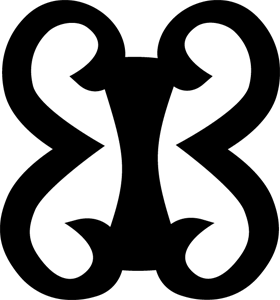
PEMPAMSIE
"sew in readiness"
symbol of readiness, steadfastness, hardiness
According to the The Adinkra Dictionary, the design of this symbol resembles the links of a chain, and implies strength through unity as well as the importance of being prepared
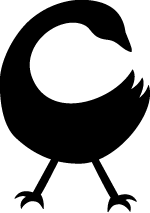
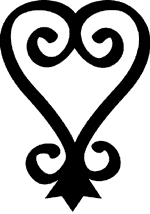
SANKOFA
"return and get it"
symbol of importance of learning from the past
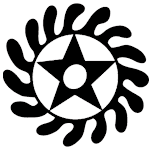
SESA WO SUBAN
"Change or transform your character "
symbol of life transformation
This symbol combines two separate adinkra symbols, the "Morning Star" which can mean a new start to the day, placed inside the wheel, representing rotation or independent movement.
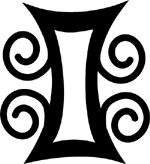
TAMFO BEBRE
"the enemy will stew in his own juice"
symbol of jealousy and envy
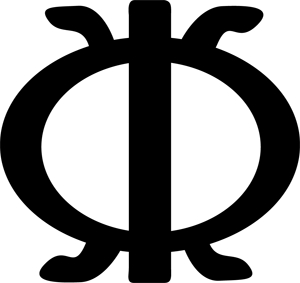
WAWA ABA
"seed of the wawa tree"
symbol of hardiness, toughness and perseverance
The seed of the wawa tree is extremely hard. In Akan culture, it is a symbol of someone who is strong and tough. It inspires the individual to persevere through hardship.
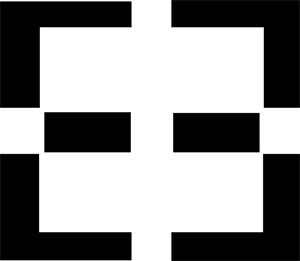
WOFORO DUA PA A
"when you climb a good tree"
symbol of support, cooperation and encouragement
From the expression "Woforo dua pa a, na yepia wo" meaning "When you climb a good tree, you are given a push". More metaphorically, it means that when you work for a good cause, you will get support.
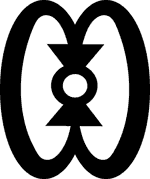
symbol of participatory government, democracy and pluralism
From the aphorism, "Wo nsa da mu a, wonni nnya wo" -- "If your hands are in the dish, people do not eat everything and leave you nothing."

ไม่มีความคิดเห็น:
แสดงความคิดเห็น